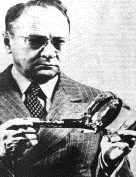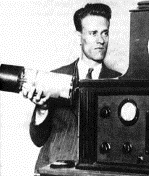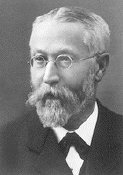



















 |



"If it weren't for Philo T. Farnsworth, the inventor of television, we'd still be eating frozen radio dinners."
-- Johnny Carson
Television's Training Ground: A View To The Past
Television: have you ever stopped to consider what impact our industry has? Even though it's only been fully established for about sixty years, the advances in it are astounding. Fifty years ago the images were small and blurry. Now, in the next millennium, they're big, bright, in colour and have accompanying full stereo audio, or 5.1 surround sound. We now take cable TV, home satellite dishes, VCRs, DVDs and DVRs for granted. And we now have wide-screen high resolution pictures in our studios and homes.
Video has become a dominant force in the lives of Canadians:
 |
99% of Canadians watch television, and the average viewer watches about 23 hours a week, or on average a little more than 3 hours every day; |
 |
52% of Canadians have two or more television sets; |
 |
more than 90% of Canadian viewers have a VCR.; |
 |
19% of us have more than one VCR; |
 |
more than 70% of Canadian viewers have cable TV. (1) |
 |
Canadians make their own videos from cameras and camcorders, or store up TV programs for later viewing, buying millions of blank videocassettes per year. And they buy or rent movies or other programs on tape and DVD - again, millions of times a year. Even older media like motion pictures increasingly depend on video technology for production and distribution. |
But It Wasn't Always That Way...
Since its start in the 1920s, broadcasting in general has provoked a variety of responses from institutions affected by it. Many businesses see it as the most important contemporary advertising medium, but many educators regard it as a foe of literacy and serious thought. Many critics have pointed out its tendency toward escapism.
In 1927 (before television), H. G. Wells condemned radio as useful only to "very sedentary persons living in badly lighted houses or otherwise unable to read...and who have no capacity for thought or conversation."
By 1961, Newton Minow (then chair of the FCC in the U.S.) had described television as a "vast wasteland...of game shows, violence...sadism, murder, western badmen, western good men, private eyes, gangsters, more violence, and cartoons."
|
It's been said that television technology is the most advanced technology on the planet. That may be a debatable point, but without a doubt, it's become part of our lives. We've witnessed man's first steps on the moon, and colour pictures from planets in the solar system. And all of this can be yours, in the privacy of your own home, for a relatively small investment.
Whatever its achievements, or whatever its failings, there's no doubt that television is capable of exerting an influence that no other medium of communication can match. This is something to think about the next time you pull a dissolve lever, roll a tape, aim a camera, slide an audio fader, count out a video, type a line of electronic text...
How It All Began
The basic concept of television - the transmission of images over distances - had challenged scientists even before the invention of the movies or radio.
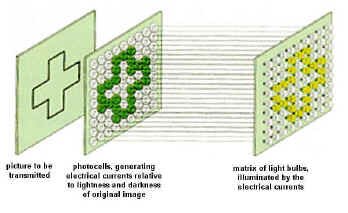 |
In 1875, George Carey in Boston proposed a system of a grid of photoelectric cells facing the image to be transmitted, connected up, in parallel, to a similar grid made up of light bulbs. It was, by definition, a very low resolution system, and would have required thousands of connections from the photocells to the bulbs. |
|
George Carey's idea (courtesy www.dvb.org)
|
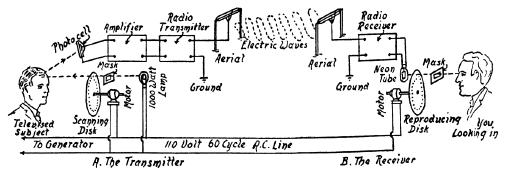 |
The Nipkow scanning disc, the basis of mechanical television, was invented in 1883. It was simply a metal disc perforated by holes arranged in a spiral. When it revolved, the disc could scan a picture placed behind it. The resulting changes in light intensity were picked up by a photoelectric cell, which converted the changes in light to an electrical signal. This signal was then sent via electric wires to a receiver where there was an identical disc turning at the same speed in front of a lamp whose brightness changed according to the received signal. |
|
The Nipkow scanning disc system
|
|
By rapidly changing the picture, the illusion of movement was achieved. Nipkow's ideas were just that - ideas, since this technology couldn't actually be implemented with the materials available in the late 19th century.
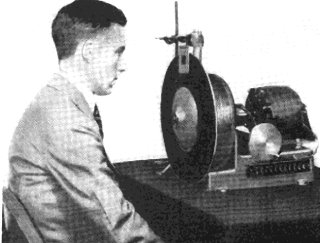 |
While viewing mechanical television, one was literally glued to the set (courtesy Popular Electronics)
|
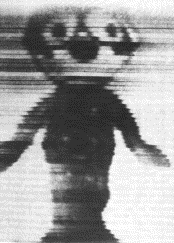 |
Felix the Cat as he looked in 60-line pictures during a 1928 telecast by RCA-NBC
|
|
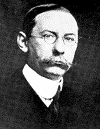
|
The present system of electronic television was proposed in detail by a Scotsman, A. A. Campbell-Swinton, in 1908, but again, his ideas were theoretical in nature, since the ability to put together cathode ray tubes wasn't ready for prime time.
As an aside, the many early television schemes envisioned transmission through wires, not over the air. Guglielmo Marconi's invention of the wireless radio (1895) spurred efforts toward over-the-air transmission of pictures, and in the late 1920s, radio and motion pictures were combined.
Charles Francis Jenkins, the inventor of the modern motion picture projector, in 1928 began regular broadcasts of crude "radiomovies" in Washington, D.C., using motion-picture film as a source.
|

|
|
A. A. Campbell-Swinton
|
Charles Francis Jenkins
|
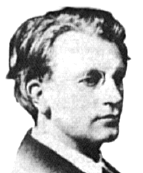 |
John Logie Baird in 1926 developed a similar mechanical TV system in Britain, based on Nipkow's concepts, which became the basis for the BBC's first regular television broadcasts. Also in the 1920s, Baird developed and demonstrated the first colour television system and the first videodisc system by converting the video signal into audio and then recording it on phonograph records. |
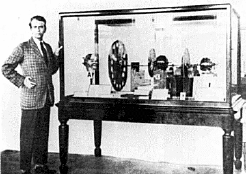 |
|
John Logie Baird
|
"The Inventor And His Machine" - John Logie Baird, 1926
|
The End Of Spinning Disks
|
The first regular broadcasts of electronic television for the public began in 1936. In London, England, they were using 405 horizontal scanning lines. France adopted a 455-line electronic system that year. As well, the Berlin Olympics were telecast with 441 lines, and watched in special viewing rooms by the people of Berlin and Leipzig. In the United States, the first public showing of television was at the 1939 World's Fair in New York, using a 340-line system. Two years later, in 1941, an industry-wide engineering committee adopted standards for a 525-line system based on specifications developed by the Radio Corporation of America (RCA). At that time there were about 7,000 television sets in the U.S., most of them in New York. However, during the Second World War, telecasting was reduced from 15 hours a week to just 4.
The system was authorized by the Federal Communications Commission (FCC) in the United States and became known as NTSC, named after the National Television System Committee, which developed it. But, it was after World War II that regular broadcasting actually began, and after 1945, television developed rapidly throughout the world, most of Europe choosing a 625-line system that was incompatible with the U.S. 525-line standard.
|
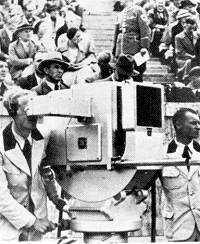
Live at the Berlin Olympics, 1936
|
| When peacetime activities resumed, television mania quickly swept the continent, on both sides of the border. Etiquette columns in the local paper urged consumers to purchase sets for the dining room to prevent families from eating in the living room. Non-TV set owners watched several hours a week at other peoples' homes. Optometrists offered special TV-watching glasses to prevent "telestrain" and viewers were advised to shift their gaze when viewing for long periods. In polls of the day, two-thirds said they did less reading, and two-thirds also did less visiting. Magazine readership went down 25%, and local bars had their patronage reduced by the same amount (that is, until they got their own TV sets!) |
Colour
|
Astoundingly, and over the objections of much of the U.S. television industry, the FCC in 1950 approved a mechanical colour television system that was incompatible with the millions of black-and-white sets then in use. It had been developed by the Columbia Broadcasting System (CBS) and involved placing rotating coloured filter wheels over both the camera imaging device and the home receiver. Eventually, a second National Television System Committee was convened to develop a compatible colour system.
The 525-line NTSC colour system gained FCC approval in 1953, but it was ten years before the public responded and bought colour sets in any significant numbers. In Europe, two different 625-line colour systems were introduced (PAL and SECAM.)
|
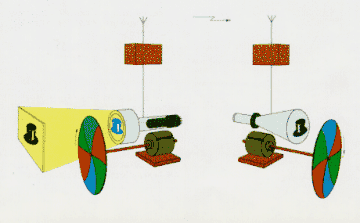 |
|
CBS' proposed (and, for a short while, approved) mechanical colour television system (courtesy www.dvb.org)
|
So, What About Canada?
In Canada, the first television station was VE9EC in Montreal, jointly owned by radio station CKAC and the newspaper La Presse. It went on the air on October 9, 1931, with neon-red pictures. One small problem - there were practically no receivers around to view the flickering images. Canadian Television Limited eventually collapsed during the Depression.
During the '40s, the Marconi Company in Montreal and Famous Players Theatre in Toronto applied for television licences. CFRB in Toronto had applied in 1938 and was denied. CKEY followed, with the same fate, in 1945. They were turned down by none other than the CBC, who ran the public broadcasting system - as well as deciding who the competition would be.
At this time, broadcasting in Canada was an organizational mess. The CBC owned several radio stations coast to coast - the Trans-Canada Network. This was distinct from the Dominion Network, which linked stations in Toronto, CJBC and many privately owned stations, and ran commercial material, including several American radio shows. And then there were the independents and those affiliated with American networks, such as CFRB. This was the foundation upon which the future of Canada's television industry would be built.
After the war, television was slow in starting back up but by 1951, there were twelve million television receivers in the U.S., and five networks: NBC, CBS, ABC, DuMont and Westinghouse. American television continued to build Canadian audiences. Many border television stations sprang up to beam television to many parts of Ontario: WBEN (now WIVB) Buffalo, WROC Rochester, WHEN and WSYR Syracuse, WWJ, WXYZ and WJBK Detroit, all signed on between 1947 and 1950. Vancouver, meanwhile, was invaded by KING Seattle in 1948. There were more than 50,000 regular Canadian viewers of WBEN Buffalo before Canadian television even started. By 1951, there were more than 90,000 television sets in Canada - all watching American stations.
Finally, on September 6, 1952, the CBC went on the air in Montreal on channel 2, with a newsreel, a bilingual variety show, a documentary about Montreal, and a ceremonial inaugural program. The evening finished with a film about television ("Kaleidoscope"), and a French production of "Oedipus Rex."
| Two days later, on September 8, CBC Toronto signed on. The first televised image was the station ID slide - shown upside down and backward. The first film to be shown broke in the gate. The programming evening began with "Let's See" hosted by Percy Saltzman (later of chalk-tossing "That's the weather..." fame). Following this was the news (featuring a "real news" story involving the famous "Boyd Gang" who had broken out of jail and had been recaptured). The official Toronto opening was celebrated, and eventually the under-three-hour broadcast day ended with a variety program from Montreal. |
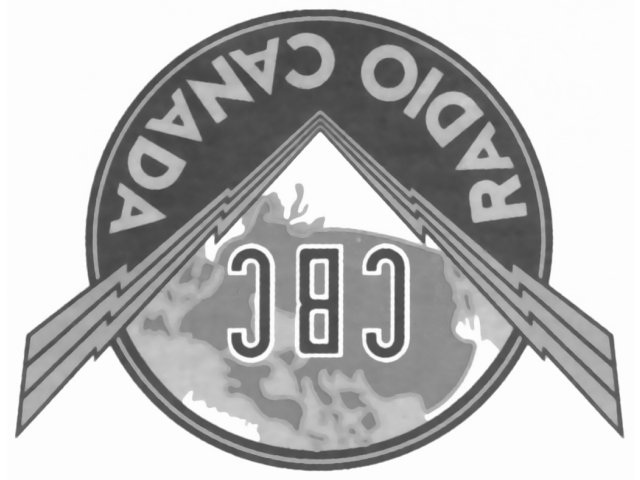 |
By 1953, there were 300,000 television receivers in Canada. Not all of them, however, were watching the CBC.
CBC television was established to produce television programs, sell television receivers and build a large and loyal audience. They had built the audience but couldn't convert many of the Canadian-based Buffalo viewers. While the Canadians were complaining about the CBC production quality, Buffalo television salesmen were selling TV sets south of the border by telling viewers how good the Canadian television programs were!
And so it began...
Things To Think About:
Never underestimate the power that we, as broadcasters, wield over the viewer. Somebody out there is watching TV over three hours, each and every day.
TV started out with a mechanical system. What was it? In simple terms, how did it work?
Who are some of the key names in the invention and evolution of electronic television?
Who are the organizing bodies that gave us the television standards we use today?
In general terms, what was going on in Canada? Why?
1. Statistics Canada, 1995











